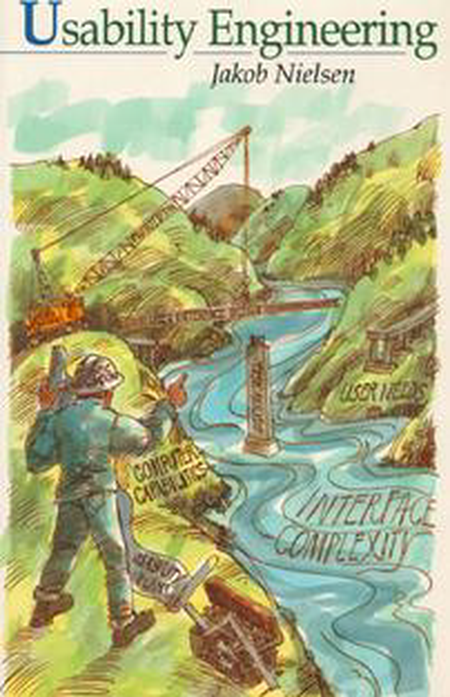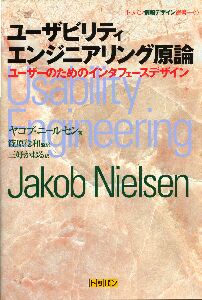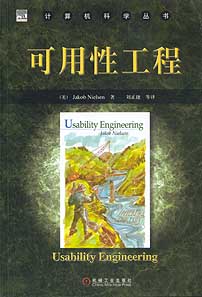Usability Engineering
Jakob Nielsen, 1993

Detailing the methods of usability engineering, this book provides the tools needed to avoid usability surprises and improve product quality. Step-by-step information on which method to use at various stages during the development lifecycle are included, along with detailed information on how to run a usability test and the unique issues relating to international usability. This book emphasizes cost-effective methods that developers can implement immediately, and instructs readers about which methods to use when, throughout the development lifecycle. Also includes strategies to avoid the four most frequently listed reasons for delay in software projects, detailed information on how to run a usability test, and an extensive bibliography allowing readers to find additional information. (Published by Morgan Kaufmann, San Francisco; ISBN 0-12-518406-9 slightly expanded paperback edition. Original hardcover edition published by AP Professional.)
Please buy through the purchase links provided here: Amazon pays me a referral fee that doubles the share of the purchase price that goes to the author, giving me time off from other projects to write new books.
New Scientist review: "It is a book that does not moan about how bad things are but shows us how to change the world and does so admirably."
Table of Contents
Preface
- Audience
- Teaching Usability Engineering
- Acknowledgments
1. Executive Summary
1.1 Cost Savings
1.2 Usability Now!
1.3 Usability Slogans
- Your Best Guess Is Not Good Enough
- The User Is Always Right
- The User Is Not Always Right
- Users Are Not Designers
- Designers Are Not Users
- Vice Presidents Are Not Users
- Less Is More
- Details Matter
- Help Doesn't
- Usability Engineering Is Process
1.4 Discount Usability Engineering
- Scenarios
- Simplified Thinking Aloud
- Heuristic Evaluation
1.5 Recipe For Action
Chapter 2: What Is Usability?
2.1 Usability and Other Considerations
2.2 Definition of Usability
- Learnability
- Efficiency of Use
- Memorability
- Few and Noncatastrophic Errors
- Subjective Satisfaction
2.3 Example: Measuring the Usability of Icons
2.4 Usability Trade-Offs
2.5 Categories of Users and Individual User Differences
Chapter 3: Generations of User Interfaces
3.1 Batch Systems
3.2 Line-Oriented Interfaces
3.3 Full-Screen Interfaces
- Menu Hierarchies
3.4 Graphical User Interfaces
3.5 Next-Generation Interfaces
3.6 Long-Term Trends in Usability
Chapter 4: The Usability Engineering Lifecycle
4.1 Know the User
- Individual User Characteristics
- Task Analysis
- Functional Analysis
- The Evolution of the User
4.2 Competitive Analysis
4.3 Goal Setting
- Financial Impact Analysis
4.4 Parallel Design
4.5 Participatory Design
4.6 Coordinating the Total Interface
4.7 Guidelines and Heuristic Evaluation
4.8 Prototyping
- Scenarios
4.9 Interface Evaluation
- Severity Ratings
4.10 Iterative Design
- Capture the Design Rationale
4.11 Follow-Up Studies of Installed Systems
4.12 Meta-Methods
4.13 Prioritizing Usability Activities
4.14 Be Prepared
Chapter 5: Usability Heuristics
5.1 Simple and Natural Dialogue
- Graphic Design and Color
- Less Is More
5.2 Speak the Users' Language
- Mappings and Metaphors
5.3 Minimize User Memory Load
5.4 Consistency
5.5 Feedback
- Response Time
- System Failure
5.6 Clearly Marked Exits
5.7 Shortcuts
5.8 Good Error Messages
- Multiple-Level Messages
5.9 Prevent Errors
- Avoid Modes
5.10 Help and Documentation
- A Model of Documentation Use
- The Minimal Manual
5.11 Heuristic Evaluation
- Effect of Evaluator Expertise
Chapter 6: Usability Testing
Reliability
Validity
6.1 Test Goals and Test Plans
- Test Plans
- Test Budget
- Pilot Tests
6.2 Getting Test Users
- Novice versus Expert Users
- Between-Subjects versus Within-Subjects Testing
6.3 Choosing Experimenters
6.4 Ethical Aspects of Tests with Human Subjects
6.5 Test Tasks
6.6 Stages of a Test
- Preparation
- Introduction
- Running the Test
- Debriefing
6.7 Performance Measurement
6.8 Thinking Aloud
- Constructive Interaction
- Retrospective Testing
- Coaching Method
6.9 Usability Laboratories
- To Videotape or Not
- Cameraless Videotaping
- Portable Usability Laboratories
- Usability Kiosks
Chapter 7: Usability Assessment Methods beyond Testing
7.1 Observation
7.2 Questionnaires and Interviews
7.3 Focus Groups
7.4 Logging Actual Use
- Combining Logging with Follow-Up Interviews
7.5 User Feedback
7.6 Choosing Usability Methods
- Combining Usability Methods
Chapter 8: Interface Standards
- User Benefits from Consistency and Standards
- Vendor Benefits from Consistency and Standards
- The Dangers of Standards
8.1 National, International and Vendor Standards
8.2 Producing Usable In-House Standards
Chapter 9: International User Interfaces
9.1 International Graphical Interfaces
- Gestural Interfaces
9.2 International Usability Engineering
9.3 Guidelines for Internationalization
- Characters
- Numbers and Currency
- Time and Measurement Units
- Don't Despair
9.4 Resource Separation
9.5 Multilocale Interfaces
Chapter 10: Future Developments
10.1 Theoretical Solutions
10.2 Technological Solutions
10.3 CAUSE Tools: Computer-Aided Usability Engineering
10.4 Technology Transfer
Appendix A: Exercises
Hints
Appendix B: Bibliography
B.1 Conference Proceedings
B.2 Journals
B.3 Introductions and Textbooks
B.4 Handbook
B.5 Reprint Collections
B.6 Important Monographs and Collections of Original Papers
B.7 Guidelines
- Style Guides
B.8 Videotapes
B.9 Other Bibliographies
- Bibliographic Databases
B.10 References
Author Index
Subject Index
The original hardcover edition had ISBN 0-12-518405-0. The hardcover edition is now out of print and has been replaced by the updated paperback edition described on this page.
Translations
First Japanese edition, Toppan Publishing, ISBN 4-8101-9009-9

Second Japanese edition, Tokyo Denki University Press, ISBN 4-501-53200-9

Chinese edition, China Machine Press, ISBN 7-111-14792-8

